光电子学课后习题chapter2&3
光电子技术基础与应用习题答案
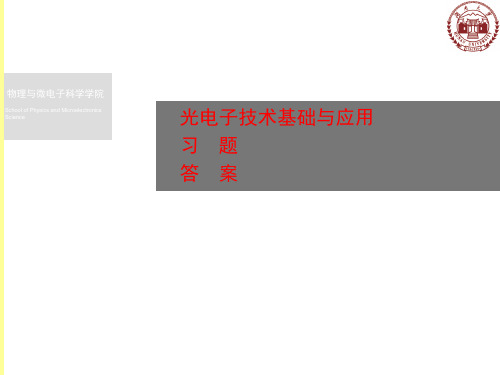
第三章 习题(1)
1. 填空
① 最早的电光源是
,最早的激光器是 年由 国的 制作的 。
② 光在各向同性介质中传播时,复极化率的实部表示 虚部表示 与频率的关系。
与频率的关系,
③ 激光器的基本结构包括 、 是 、 ,必要条件包括
、 。激光产生的充分条件
、
。
④ 今有一个球面激光腔r1=1.5m,r2=-1m,L=80cm,它属于 2. 试简单说明以下光电子学术语的科学含义:
8. 从麦克斯韦通式(2-28)出发,推导波动方程(2-44)。
1. 填空题:
第二章 习题答案(1)
第二章 习题答案(2)
第二章 习题答案(3)
6. 输出波长为=632.8nm的He-Ne激光器中的反射镜是在玻璃上交替涂覆ZnS和 ThF2形成的,这两种材料的折射率系数分别为1.5和2.5。问至少涂覆多少个双层 才能使镜面反射系数大于99.5%?
第三章复习思考题(8)
4. 简述题 (5)以一个三能级原子系统为例, 说明激光器的基本组成和产生激光的基本原理。
4. 简述题
第三章复习思考题(9)
4. 简述题 (7)分析激光产生的条件。
第三章复习思考题(10)
4. 简述题 (7)分析激光产生的条件。
第三章复习思考题(11)
4. 简述题
第三章复习思考题(12)
讲授内容
第三、四、五讲
1 第一章 绪 论(一讲) 2 第二章 光学基础知识与光场传播规律(二讲)
3 第三章 激光原理与技术(三、四、五讲)
4 第四章 光波导技术基础(六、七讲) 5 第五章 光调制技术—光信息系统的信号加载与控制(八、九、十讲)
6 第六章 光电探测技术(十一、十二讲)
光电子学与光子学讲义-作业答案(第1、2章)13版.doc
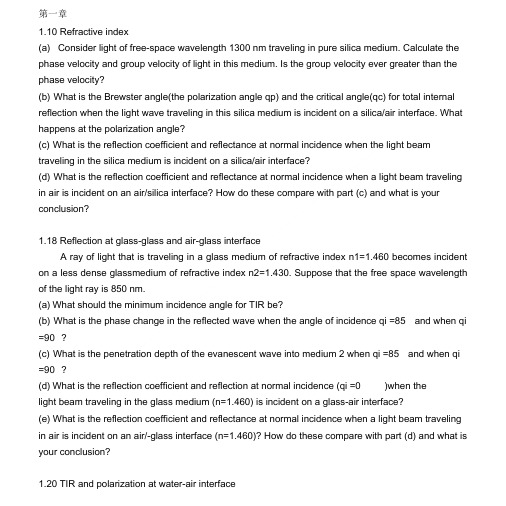
第一章1.10 Refractive index(a) Consider light of free-space wavelength 1300 nm traveling in pure silica medium. Calculate the phase velocity and group velocity of light in this medium. Is the group velocity ever greater than the phase velocity?(b) What is the Brewster angle(the polarization angle qp) and the critical angle(qc) for total internal reflection when the light wave traveling in this silica medium is incident on a silica/air interface. What happens at the polarization angle?(c) What is the reflection coefficient and reflectance at normal incidence when the light beam traveling in the silica medium is incident on a silica/air interface?(d) What is the reflection coefficient and reflectance at normal incidence when a light beam traveling in air is incident on an air/silica interface? How do these compare with part (c) and what is your conclusion?1.18 Reflection at glass-glass and air-glass interfaceA ray of light that is traveling in a glass medium of refractive index n1=1.460 becomes incident on a less dense glassmedium of refractive index n2=1.430. Suppose that the free space wavelength of the light ray is 850 nm.(a) What should the minimum incidence angle for TIR be?(b) What is the phase change in the reflected wave when the angle of incidence qi =85 ° and when qi =90° ?(c) What is the penetration depth of the evanescent wave into medium 2 when qi =85 ° and when qi =90° ?(d) What is the reflection coefficient and reflection at normal incidence (qi =0 ° )when thelight beam traveling in the glass medium (n=1.460) is incident on a glass-air interface?(e) What is the reflection coefficient and reflectance at normal incidence when a light beam traveling in air is incident on an air/-glass interface (n=1.460)? How do these compare with part (d) and what is your conclusion?1.20 TIR and polarization at water-air interface(1) Given that the refractive index of water is about 1.33, what is the polarization angle for light traveling in air and reflected from the surface of the water?(2) consider a diver in sea pointing a flashlight towards the surface of the water. What is the critical angle for the light beam to be reflected from the water surface?1.22 phase changes on TIRConsider a lightwave of wavelength 870nm traveling in a semiconductor medium (GaAs) of refractive index 3.6. It is incident on a different semiconductor medium (AIGaAs) of°. Will this result in total internal refractive index 3.4, and the angle of incidence is 80reflection? Calculate the phase change in the parallel and perpendicular components of the reflected electric field?1.25 Goos-Haenchen phase shiftAray of light that is traveling in a glass medium(1) of refractive index n1 =1.460 becomes incident on a less dense glass medium(2) of refractive index n2=1.430. Suppose that the free space wavelength of the light ray is 850nm.the angle of incidence(9=85 . Estimate the lateral Goos-Haenchen shift in the reflected wave for the perpendicular field component. Recalculate the Goos-Haenchen shift in the secondmedium has n2=1 (air). What is your conclusion?Assume that the virtual reflection occurs from a virtual plane in medium B at a distance d that is roughly the same as the penetration depth.Note that d actually depends on the polarization ,the direction of the field,but we will ignore this dependence.第二章作业习题:2.7Dielectric slab waveguide Consider a dielectric slab waveguide that has a thin GaAs layer of thickness 0.25 /w between two AIGaAs layers. The refractive index of GaAs is3.6 and that of the AIGaAs layers is 3.40. What is the cut-off wavelength beyond which only a single mode can propagate in the waveguide, assuming that the refractive index does not vary greatly with thewavelength? If a radiation of wavelength 860 nm (corresponding to bandgap radiation) is propagating in the GaAs layer, what is the penetration of the evanescent wave into the AIGaAs layer? What is the mode field width (MFW) of this radiation? Point out the effect of change of radiation wavelength (为on the MFW.2.9 Dielectric slab waveguide Consider a planar dielectric waveguide with a core thickness 10/m,ni=1.4446, n2=1.4440. Calculate the V -number, the mode angle 劣for m=0 (use a graphical solution, if necessary), penetration depth, and mode field distance (MFW=2 c(^2 9, for light wavelengths of 1.0 /xn and 5 /jn. What is your conclusion? Compare your MFW calculationwith 2»o =2a (V +1 )/V .The model angle 3is given as &=88.85?for ^=1 /m and ^=88.72 ?for ^=1.5 仰for the fundamental mode m=0.2.10 A multimode fibe r Consider a multimode fiber with a core diameter of 60 /m, core refractive index of 1.47, and a cladding refractive index of 1.45 both at 870 nm. Consider operating this fiber at ^=870nm.(e) Calculate the numerical aperture.(f) Find out the normalized core-cladding index difference.(g) Calculate the V-number for the fiber and estimate the number of guided modes.(h) Calculate the wavelength beyond which the fiber becomes single-mode.(i) Calculate the modal dispersion △ T and hence the bit rate x distance product.2.12 Single mode fiber Consider a fiber with a S1O2-13.5% GeOz core of diameter of 6 Wi and refractive index of 1.47 and a cladding refractive index of 1.46 both refractive indices at 1300 nm where the fiber is to be operated using a laser source with a half maximum width (FWHM) of 2 nm.. (j) Calculate the V -number for the fiver.(k) what is the maximum allowed diameter of the core that maintains oprations in single-mode?(l) Calculate the wavelength below which the fiber becomes multimode.(m) C alculate the numerical aperture.(n) Calculate the maximum acceptance angle.(o) Obtain the material dispersion and wavelength dispersion and hence estimate the bit rate x distance product ( B x L) of the fiber.。
光电子技术及应用(第2版)章节习题及自测题参考答案

光电子技术及应用(第2版)章节习题及自测题参考答案第一章习题参考答案一、单选题1.ABCD2.ABC3.ABC4.D5.B6.C7.B8.B9. A 10.A二、填空题11.500,30012.无线电波,.红外光,可见光和紫外光,X 射线,γ射线13.0.77---1000μm ,近红外,中红外和远红外14.泵浦源,谐振腔和激活介质15.频率,相位,振幅及传播方向16.受激辐射,实现粒子数反转,谐振腔;方向性好,相干性好,亮度高 17.935μm18.919.125103.1--⋅⋅⨯s m kg20.三、计算题21.解:(1)根据距离平方反比定律2/R I E e e =,太阳的辐射强度为sr W R E I e e /10028.3252⨯==。
得到太阳的总功率为W I e e 26108.34⨯==Φπ(2)太阳的辐射亮度为()sr cm W A I L e ./10989.127⨯== 太阳的辐射出射度为27/1025.6m W L M e e ⨯==π 太阳的温度为K M T e 57614==σ22.解:222z r r ='=,22cos cos z r z+'='=θθ,r d r dS '∆'=ϕ 由:2cos cos r BdS S d d dE θθ'='Φ'=2202222022)(2cos 2z R RB z r r d r z B r d r r B E R R+=+'''=''=⎰⎰ππθπ 23.解:设相干时间为τ,则相干长度为光束与相干时间的乘积,即c L c ⋅=τ 根据相干时间和谱线宽度的关系c L c v ==∆τ1 又因为00γλλv ∆=∆,λc v =0,nm 8.6320=λ由以上各关系及数据可以得到如下形式:单色性=101200010328.6108.632-⨯===∆=∆nm nm L v v c λλλ 24.证明:若t=0时刻,单位体积中E 2能级的粒子数为n 20,则单位体积中在t→t+dt 时间内因自发辐射而减少的E2能级的粒子数为:2122122120A t dn A n dt A n e dt --==故这部分粒子的寿命为t ,因此E2能级粒子的平均寿命为212120020211A t tA n e dtn A τ∞-==⎰ 25.解:设两腔镜1M 和2M 的曲率半径分别为1R 和2R ,121m,2m R R =-=工作物质长0.5m l =,折射率 1.52η=根据稳定条件判据:(1) 其中(2) 由(1)解出2m 1m L '>>由(2)得所以得到: 2.17m 1.17m L >>第二章习题参考答案011 1 21L L ''⎛⎫⎛⎫<-+< ⎪⎪⎝⎭⎝⎭() l L L l η'=-+10.5(1)0.171.52L L L ''=+⨯-=+一、选择题1.ABCD2.D3.ABCD4.AC5.ABCD6.A7.A8.A9.A 10. B二、 是非题911.√ 12.× 13.× 14.× 15.√ 16.√三、 填空题17.大气气体分子及气溶胶的吸收和散射;空气折射率不均匀;晶体介质的介电系数与晶体中的电荷分布有关,当晶体被施加电压后,将引起束缚电荷的重新分布,并导致离子晶格的微小形变,从而引起介电系数的变化,并最终导致晶体折射率变化的现象。
光电子学课程习题集答案

03电子科学与技术Company Logo
好好学习,天天上上
4. 解:线性函数表示总辐射功率为I 0 的光谱中,其中落在频率
~ d
内的辐射功率与总功率之比随频率的分布情况 。
Ie e / 4 2.4w sr 1
I e Le 3 105 W m 2 sr 1 A
辐射照度:
e I e Ee A A
I e A
R 2 I e 2.4 26.67W m 2 A R 2 0.32
03电子科学与技术Company Logo
1 I ( x) G ln x I0
1 1 ln 2 ln 8 5 x
则x=15CM
03电子科学与技术Company Logo
好好学习,天天上上
2。一光束入射到长为10CM,增益系数为0.5CM 的工作物质中,求出射光强对入射光强的比值。 答: 利用增益系数的公式
好好学习,天天上上
5。增益饱和现象产生的原因是什么?饱和光 强的物理意义是什么?
答:粒子数反转Δn与入射光强度和频率有关。 根据P38(式2-1-22)和P40(式2-2-9),当光强I很小 时,G(v)可视为跟I无关,值很大。当I较大,相当于光与激 活介质的作用范围大,效率高,消耗的粒子多,即△n剧减, 故G(v)也随之减少,即出现了增益系数随光强的增大而下降 的增益饱和现象。 粒子数反转Δn的饱和将导致增益饱和。设光强I达到Is 时,Δn开始饱和,称Is为饱和光强。 (下页续)
1V / c 1V / c
反射回来的光波跟物体是相背运动,则V<0,故令V=
10光电子学第2章-2
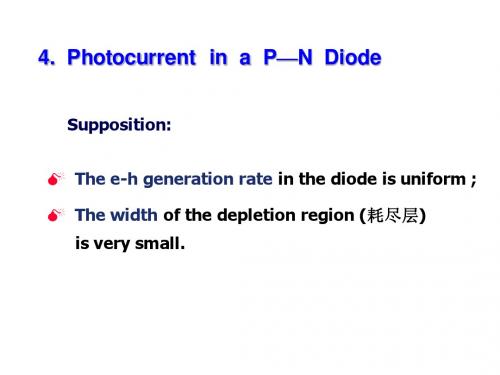
(
(
)( ) = 0.715V )
The depletion width is now
2ε rε 0 N a + N d W= N N (Vbi + VR ) e a d
2(11.9)(8.85 × 10 = (1.6 × 10 −19 ) = 0.73µm
0
The path of solution of I nL、I pL :
I nL、I pL
⇐
excess carriers due to light absorption
⇐
the steady state continuity equation (稳态连续性方程 稳态连续性方程) 稳态连续性方程
Steady state continuity equation
A = 104 µm 2
τ n = 10 s τ p = 10 −8 s
Dn = 20cm 2 / s Dp = 12cm 2 / s −8
N a = 2 × 1016 cm −3 N d = 1016 cm −3
G L = 10 22 cm −3s −1
Calculation: photocurrent I L
IL = I pL + InL + IL1 = eGL (Lp + Ln +W ) A
Solution :
The electron diffusion length is
L n = Dnτ n = (20) 10
The hole diffusion length is
[ (
−8
)]
1
2
= 4.5 µm
光电子学与光子学的原理及应用第二章-课后答案

光电子学与光子学的原理及应用第二章-课后答案1. 选择题1.1 题目一答案:C解析:光电效应是指物质受到光的照射后,吸收光能,将光能转化为电能的一种现象。
光电效应首先是由爱因斯坦在1905年提出的,他在描述光电效应时,引入了光子概念,假设光是由一组个别粒子组成的(即光量子),这些粒子就是后来被称为光子的电磁辐射量子。
1.2 题目二答案:A解析:光电倍增管是指通过光电效应,在光电面上光电发射物质外壳的钨丝和灯管之间加一个高达2000-3000伏的电压使其产生光电流,再对光电流进行电子倍增,最后输出检测的一种光电探测器。
光电倍增管的结构与普通的电子管相似,但是在各个电极和玻璃壳之间加入了紧密和高度真空的保护,同时在阳极和阳极网之间还添加了一个用直流电压加电的光电体。
当阳极对外加正电压使阳极电流开始增大时,就成为光电倍增管。
1.3 题目三答案:D解析:光电二极管是一种能够将光信号转化为电信号的器件。
光电二极管的基本原理是利用半导体材料的PN结在光照射下产生光电效应,使得PN结两端产生电荷,从而产生电压信号。
光电二极管的结构和普通二极管类似,主要由P型和N型的半导体材料组成,当光照射到光电二极管上时,光子能量被半导体材料所吸收,产生的热力激发电子,从而引起半导体PN结的载流子的复合和流动,产生感光电流。
光电二极管应用广泛,如光通信、光电测量、光谱分析等领域。
1.4 题目四答案:B解析:光导纤维是一种能够传输光信号的特殊纤维材料。
光导纤维的核心部分是由高折射率的材料构成,而外部由低折射率的材料构成。
当光线传输到光导纤维中时,会发生全反射现象,使得光线能够沿着光导纤维进行传输,最终到达目标地点。
光导纤维具有传输距离远、损耗小、带宽大、抗电磁干扰等优点,在通信、医疗、传感等领域得到广泛应用。
2. 填空题2.1 题目一答案:钠解析:钠具有低电离电势,激发电子的能量比较低,是光电电子极容易脱离的材料之一。
2.2 题目二答案:光电效应解析:光电效应是指物质受到光的照射后,吸收光能,将光能转化为电能的一种现象。
光电子发光与显示技术 课后作业及答案
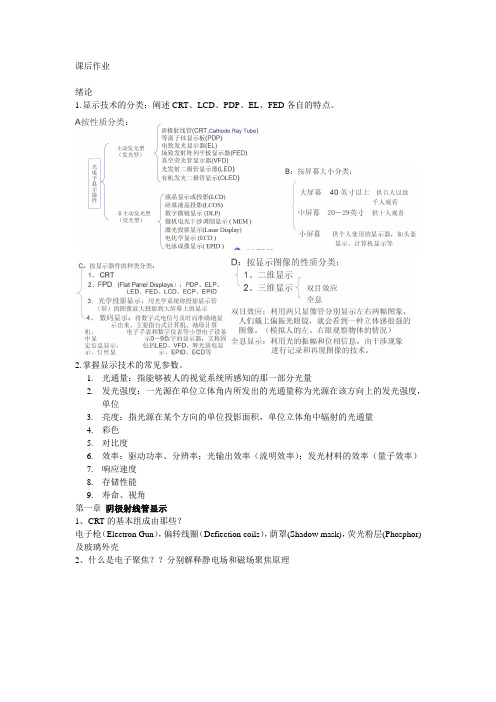
课后作业绪论1.显示技术的分类;阐述CRT、LCD、PDP、EL、FED各自的特点。
2.掌握显示技术的常见参数。
1.光通量:指能够被人的视觉系统所感知的那一部分光量2.发光强度:一光源在单位立体角内所发出的光通量称为光源在该方向上的发光强度,单位3.亮度:指光源在某个方向的单位投影面积,单位立体角中辐射的光通量4.彩色5.对比度6.效率:驱动功率、分辨率;光输出效率(流明效率);发光材料的效率(量子效率)7.响应速度8.存储性能9.寿命、视角第一章阴极射线管显示1、CRT的基本组成由那些?电子枪(Electron Gun),偏转线圈(Defiection coils),荫罩(Shadow mask),荧光粉层(Phosphor)及玻璃外壳2、什么是电子聚焦??分别解释静电场和磁场聚焦原理一束发散角不大的带电粒子束,当它们在磁场B的方向上具有大致相同的速度分量时,它们有相同的螺距。
经过一个周期它们将重新会聚在另一点,这种发散粒子束会聚到一点的现象与透镜将光束聚焦现象十分相似,因此叫磁聚焦3、CRT扫描方式有哪些?其工作原理是什么按电子束运动的规则可分为光栅扫描、圆扫描、螺旋扫描等隔行(interlaced)和逐行(progressive)电子束在通过两个偏转磁场时,在荧光屏上做从上到下、从左到右的匀速往复直线扫描动动。
我们将一行紧跟一行的抚摸方式称为逐行扫描,在逐行扫描过程中,其图像信号的时间顺序与空间顺序是一致的。
隔行扫描即是把一帧分为两场来扫描,每秒扫描50场。
规定奇数行1,3,5,7…573(显示行,其它为场逆程非显示行)的场为奇数场,偶数行2,4,6,…574的场为偶数场。
若采用奇、偶两场均匀相互嵌套的话,即可以获得高的清晰度,又能保证每帧扫描起点相同,两场的扫描锯齿电流规律相同,大大降低了对扫描电路的要求。
4、三基色混色原理有那些?并分别列出几种混色关系?三基色的本质是三基色具有独立性,三基色中任何一色都不能用其余两种色彩合成。
光电子技术课后答案
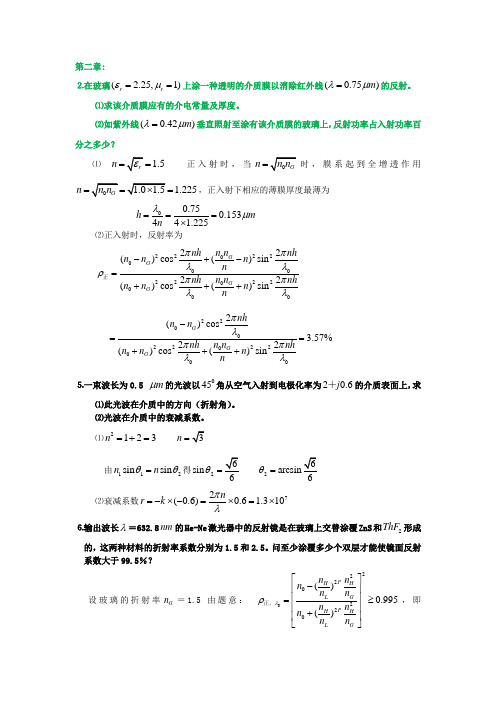
第二章:⒉在玻璃( 2.25,1)r r εμ==上涂一种透明的介质膜以消除红外线(0.75)m λμ=的反射。
⑴求该介质膜应有的介电常量及厚度。
⑵如紫外线(0.42)m λμ=垂直照射至涂有该介质膜的玻璃上,反射功率占入射功率百分之多少?⑴1.5n = 正入射时,当n =时,膜系起到全增透作用5 1.225n ==,正入射下相应的薄膜厚度最薄为 00.750.15344 1.225h m nλμ===⨯⑵正入射时,反射率为222200002222000022()cos ()sin 22()cos ()sin G G G G n n nhnhn n n n n n nh nhn n n n ππλλρππλλ-+-=+++正220022220002()cos 3.57%22()cos ()sin G G G nhn n n n nhnhn n n n πλππλλ-==+++⒌一束波长为0.5 m μ的光波以045角从空气入射到电极化率为20.6j +的介质表面上,求⑴此光波在介质中的方向(折射角)。
⑵光波在介质中的衰减系数。
⑴2123n =+=n = 由112sin sin n n θθ=得2sin 6θ=2arcsin 6θ= ⑵衰减系数72(0.6)0.6 1.310nr k πλ=-⨯-=⨯=⨯⒍输出波长λ=632.8nm 的He-Ne 激光器中的反射镜是在玻璃上交替涂覆ZnS 和2ThF 形成的,这两种材料的折射率系数分别为1.5和2.5。
问至少涂覆多少个双层才能使镜面反射系数大于99.5%?设玻璃的折射率G n =1.5 由题意: 02220220()0.995()P H H LG P H H L Gn n n n n n n n n n λρ⎡⎤-⎢⎥⎢⎥=≥⎢⎥+⎢⎥⎣⎦正,,即22222.5 1.51()1.5 1.50.99752.5 1.51()1.5 1.5P P -≤-+ 即 250.0025() 1.5 1.99753P ⨯⨯≥25()532.73P≥ 212.3P = 7P ≈ 故至少涂覆7个双层。
光电子技术书后答案

6在电光晶体的纵向应用中,如果光波偏离晶体的一个小角度(《1) 传播,证明由于自然双折射引起的相位延迟为,式中L为晶体长度。 证明:运用晶体椭球方程和光波在晶体中的传播特性及自然双折射原理
7. 若取vs=616m/s,n=2.35, fs=10MHz,0=0.6328m,试估算发生拉曼纳斯衍射所允许的最大晶体长度Lmax=?
答:对某些特定的波长,大气吸收呈现出极为强烈的吸收。根据大 气的选择吸收特性,一般把近红外区分成8个区段,将透过率较高的波 段称为“大气窗口”。位于大气窗口内的光辐射对大气分子的吸收几乎 免疫,所以衰减因素主要是大气分子的散射、大气气溶胶的衰减和大气 湍流效应。
2. 何为大气湍流效应,大气湍流对光束的传播产生哪些影响? 答:大气始终处于一种湍流效应,即大气的折射率随时间和空间做
原理后面章节会涉及到。而热辐射是指由于物体中的分子、原子受到热 激发而发射电磁波的现象。因此霓虹灯放电不属于热辐射。
5刚粉刷完的房间从房外远处看,它的窗口总显得特别黑暗,这是为什 么?
解:因为刚粉刷完的房间需要吸收光线,故从房外远处看它的窗口 总显得特别黑暗
6. 从黑体辐射曲线图可以看出,不同温度下的黑体辐射曲线的极大值处 的波长m随温度T的升高而减小。试由普朗克热辐射公式导出
22如图1-41所示,玻璃块周围介质(水)的折射率为1.33,若光束射向 玻璃块的入射角为,问玻璃块的折射率至少应为多大才能使透入光速 发生全反射?
n
解:设玻璃的折射率为由折射定律得(式中=90- ),且时发生全反射, 所以玻璃的折射率满足,由此解得玻璃的折射率。
习 题2
1. 何为大气窗口,试分析光谱位于大气窗口内的光辐射的大气衰减因 素。
由于外加电场的作用,折射率椭球各系数随之发生线形变 化,其变化量定义为 式中称为线性电光系数。
《光电子技术基础》(第二版)Chap2

椭圆偏振光和圆偏振光
椭 圆 偏 振 光
线偏光
圆偏振光
定义:光矢量末端的运动轨迹是椭圆或圆。
在迎光矢量图上,光矢量端点沿逆时针方向旋转的称为 左旋偏振光;沿顺时针方向旋转的称为右旋偏振光。
新坐标系下为标准椭圆,利用交叉项等于零,得
0.5arctan[(2E0x Eoy cos ) / (E
没有优势方向
自然光的分解
v
E
符号表示
部分偏振光
定义:某一方向的光振动比与之垂直方向上的光振 动占优势的光为部分偏振光 .
振动各个方向都有,但是方向的振幅大小不同。 可以看作是偏振光与自然光的混合。
符号表示
椭圆偏振光和圆偏振光
方向相互垂直,相位差为 / 2的两列波的叠加: E1 =E 0 cos( kz wt )ex E2 E0 sin( kz wt )e y E E1 E2 E0 [cos(kz wt )ex sin( kz wt )e y ] 运动轨迹为一个圆。当两列波振幅不同时 , 为椭圆轨迹。 当相位差不是 / 2有什么结果?
我们把能产生相干叠加的两束光称为相干光,相 干叠加必须满足振动频率相同,振动方向相同, 相位差恒定的必要条件。
光波的干涉特性
当具有相同频率和振动方向、具有相同相位或 固定相位差的光波相遇时,在相遇的区域内产 生干涉现象。 光波的干涉可以这样来描述:两列光波在空间 相遇,叠加波形成有规律的光强分布的现象。
介质ቤተ መጻሕፍቲ ባይዱ电磁性质方程
为了求解麦克斯韦方程组,还需要知道介质的电磁性质方程:
D 0 E P E
B 0 H 0 M H
J E J s
必须指出:以上关系式只适用于某些介质。实验指出存在许多不同类 型的介质,例如许多晶体属于各向异性介质,在这些介质内某些方向 容易极化,另一些方向较难极化,使得D与E一般具有不同方向,关 系就变成较为复杂的张量式。在强场作用下许多介质呈现非线性现象, 使得D不仅与E的一次式有关,而且与E的二次式、三次式等都有关系。 铁磁性物质的B与H的关系也是非线性的,而且是非单值的。
光电子学(二)_西安交通大学中国大学mooc课后章节答案期末考试题库2023年

光电子学(二)_西安交通大学中国大学mooc课后章节答案期末考试题库2023年1.把被调制的光信号转换成电信号并将信息提取出来的技术被称为()。
答案:光电探测技术2.电导率平行于与垂直于分子轴方向的分量不同的性质称为电导()。
答案:各向异性3.固体发光材料在电场激发下发光的现象称为()。
答案:场致发光##%_YZPRLFH_%##电致发光4.衡量输入光功率中从连接器反射并沿输入通道反向传输的光功率占输入光功率的份额称为()。
答案:回损##%_YZPRLFH_%##后向反射损耗5.由纤芯横向错位引起的()损耗,是连接损耗的重要原因。
答案:纤芯错位##%_YZPRLFH_%##错位6.光纤连接器的基本结构中包括对中、插针和()三个部分。
答案:端面7.将具有吸收特性的衰减片通过机械装置直接固定在光纤的端面上或准直光路中得到的光衰减器称为()光衰减器。
答案:衰减片型8.在耦合器正常工作时输入侧非注光端的输出工功率与全部注入光功率比值的分贝数称为()。
答案:方向性9.对光波波长进行分离与合成的光无源器件称为()。
答案:光波分复用器10.信息“写入”利用的是激光的单色性和()。
答案:相干性11.根据工作原理可以将光开关分为机械式、MEMS式和()式三大类。
答案:集成光波导12.拉曼-奈斯衍射与布拉格衍射的判断依据是用声光互相作用特征长度表示的。
答案:正确13.入射光波矢量方向与外加电场一致的电光效应称为()。
答案:纵向电光效应14.第一片光盘是由美国的ECD和()公司共同研制的。
答案:IBM15.一次写入光盘是利用()在存储介质的微区不可逆的物理化学变化进行信息记录的盘片。
答案:激光光斑16.提高光盘存储密度的途径中见效最快的是()以缩小记录光斑尺寸的方法。
答案:激光波长17.利用记录介质在连个稳定态之间的可逆相结构变化来实现写和擦的光盘称为()。
答案:可擦重写光盘##%_YZPRLFH_%##RM##%_YZPRLFH_%##RM相变光盘18.高级晶族中介电常量有()独立的分量。
光电子学与光子学讲义-作业答案(第1、2章)13版
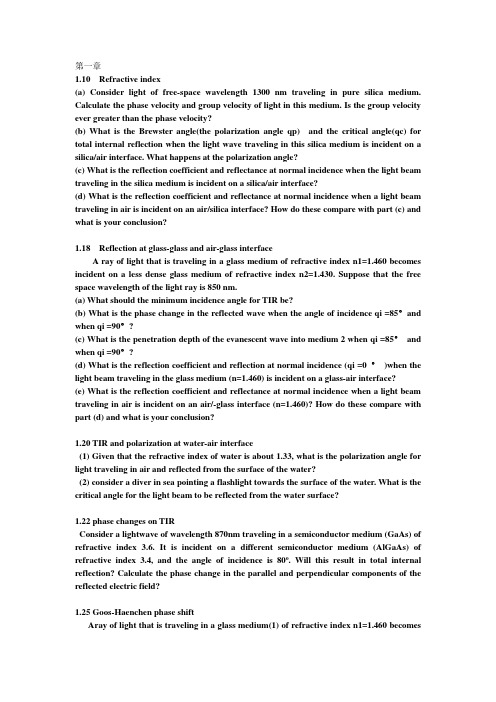
第一章1.10 Refractive index(a) Consider light of free-space wavelength 1300 nm traveling in pure silica medium. Calculate the phase velocity and group velocity of light in this medium. Is the group velocity ever greater than the phase velocity?(b) What is the Brewster angle(the polarization angle qp) and the critical angle(qc) for total internal reflection when the light wave traveling in this silica medium is incident on a silica/air interface. What happens at the polarization angle?(c) What is the reflection coefficient and reflectance at normal incidence when the light beam traveling in the silica medium is incident on a silica/air interface?(d) What is the reflection coefficient and reflectance at normal incidence when a light beam traveling in air is incident on an air/silica interface? How do these compare with part (c) and what is your conclusion?1.18 Reflection at glass-glass and air-glass interfaceA ray of light that is traveling in a glass medium of refractive index n1=1.460 becomes incident on a less dense glass medium of refractive index n2=1.430. Suppose that the free space wavelength of the light ray is 850 nm.(a) What should the minimum incidence angle for TIR be?(b) What is the phase change in the reflected wave when the angle of incidence qi =85°and when qi =90°?(c) What is the penetration depth of the evanescent wave into medium 2 when qi =85°and when qi =90°?(d) What is the reflection coefficient and reflection at normal incidence (qi =0 °)when the light beam traveling in the glass medium (n=1.460) is incident on a glass-air interface? (e) What is the reflection coefficient and reflectance at normal incidence when a light beam traveling in air is incident on an air/-glass interface (n=1.460)? How do these compare with part (d) and what is your conclusion?1.20 TIR and polarization at water-air interface(1) Given that the refractive index of water is about 1.33, what is the polarization angle for light traveling in air and reflected from the surface of the water?(2) consider a diver in sea pointing a flashlight towards the surface of the water. What is the critical angle for the light beam to be reflected from the water surface?1.22 phase changes on TIRConsider a lightwave of wavelength 870nm traveling in a semiconductor medium (GaAs) of refractive index 3.6. It is incident on a different semiconductor medium (AlGaAs) of refractive index 3.4, and the angle of incidence is 80o. Will this result in total internal reflection? Calculate the phase change in the parallel and perpendicular components of the reflected electric field?1.25 Goos-Haenchen phase shiftAray of light that is traveling in a glass medium(1) of refractive index n1=1.460 becomesincident on a less dense glass medium(2) of refractive index n2=1.430. Suppose that the free space wavelength of the light ray is 850nm.the angle of incidence θi =85°. Estimate the lateral Goos-Haenchen shift in the reflected wave for the perpendicular field component. Recalculate the Goos-Haenchen shift in the second medium has n2=1 (air). What is your conclusion?Assume that the virtual reflection occurs from a virtual plane in medium B at a distance d that is roughly the same as the penetration depth.Note that d actually depends on the polarization ,the direction of the field,but we will ignore this dependence.第二章 作业习题:θ2.7 Dielectric slab waveguide Consider a dielectric slab waveguide that has a thin GaAs layer of thickness 0.25μm between two AlGaAs layers. The refractive index of GaAs is3.6 and that of the AlGaAs layers is 3.40. What is the cut-off wavelength beyond which only a single mode can propagate in the waveguide, assuming that the refractive index does not vary greatly with the wavelength? If a radiation of wavelength 860 nm (corresponding to bandgap radiation) is propagating in the GaAs layer, what is the penetration of the evanescent wave into the AlGaAs layer? What is the mode field width (MFW) of this radiation? Point out the effect of change of radiation wavelength (λ) on the MFW.2.9 Dielectric slab waveguide Consider a planar dielectric waveguide with a core thickness 10μm , n 1=1.4446, n 2=1.4440. Calculate the V -number, the mode angle θm for m=0 (use a graphical solution, if necessary), penetration depth, and mode field distance (MFW=2α+2δ), for light wavelengths of 1.0μm and 5μm . What is your conclusion? Compare your MFW calculation with ()0221/a V V ω=+.The model angle θ0is given as θ0=88.85ᵒ for λ=1μm and θ0=88.72ᵒ for λ=1.5μm for the fundamental mode m=0.2.10 A multimode fibe r Consider a multimode fiber with a core diameter of 60μm , core refractive index of 1.47, and a cladding refractive index of 1.45 both at 870 nm. Consider operating this fiber at λ=870n m .(a) Calculate the numerical aperture.(b) Find out the normalized core-cladding index difference.(c) Calculate the V-number for the fiber and estimate the number of guided modes.(d) Calculate the wavelength beyond which the fiber becomes single-mode.(e) Calculate the modal dispersion τ∆and hence the bit rate ⨯distance product .2.12 Single mode fiber Consider a fiber with a 2SiO -13.5%2GeO core of diameter of 6m μ and refractive index of 1.47 and a cladding refractive index of 1.46 both refractive indices at 1300 nm where the fiber is to be operated using a laser source with a half maximum width (FWHM) of 2 nm..(a) Calculate the V -number for the fiver.(b)what is the maximum allowed diameter of the core that maintains oprations in single-mode?(c) Calculate the wavelength below which the fiber becomes multimode.(d) Calculate the numerical aperture.(e) Calculate the maximum acceptance angle.(f)Obtain the material dispersion and wavelength dispersion and hence estimate the bit rate⨯) of the fiber.⨯distance product (B L。
光电子学与光子学的原理及应用s.o.kasa 课后答案

1.4 Antireflection coating
For light traveling in medium 1 incident on the 1-2 interface at normal incidence,
For SiO2 For TiO2
d = λ = 900 × 10−9 m = 0.15 µm
4 n2
4(1.5)
d = λ = 900 × 10−9 m = 0.10 µm
4n2
4(2.3)
1.8 Thin film coating and multiple reflections:
Assume that n1 < n2 < n3 and that the thickness of the coating is d. For simplicity, we will assume normal incidence. The phase change in traversing the coating thickness d is φ = (2π/λ)n2d where λ is the free space wavelength. The wave has to be multiplied by exp(−jφ) to account for this phase difference.
The phase change for wave B going through the coating of thickness d is 2k2d where k2 = n2ko and ko = wavevector in free space = 2π/λ. This should be 180° or π. Thus we need 2n2(2π/λ)d = π or
第二版《光电子技术》课后习题答案

1.1可见光的波长、频率和光子的能量范围分别是多少? 波长:380~780nm 400~760nm 频率:385T~790THz 400T~750THz 能量:1.6~3.2eV1.2辐射度量与光度量的根本区别是什么?为什么量子流速率的计算公式中不能出现光度量? 为了定量分析光与物质相互作用所产生的光电效应,分析光电敏感器件的光电特性,以及用光电敏感器件进行光谱、光度的定量计算,常需要对光辐射给出相应的计量参数和量纲。
辐射度量与光度量是光辐射的两种不同的度量方法。
根本区别在于:前者是物理(或客观)的计量方法,称为辐射度量学计量方法或辐射度参数,它适用于整个电磁辐射谱区,对辐射量进行物理的计量;后者是生理(或主观)的计量方法,是以人眼所能看见的光对大脑的刺激程度来对光进行计算,称为光度参数。
因为光度参数只适用于0.38~0.78um 的可见光谱区域,是对光强度的主观评价,超过这个谱区,光度参数没有任何意义。
而量子流是在整个电磁辐射,所以量子流速率的计算公式中不能出现光度量.光源在给定波长λ处,将λ~λ+d λ范围内发射的辐射通量 d Φe ,除以该波长λ的光子能量h ν,就得到光源在λ处每秒发射的光子数,称为光谱量子流速率。
1.3一只白炽灯,假设各向发光均匀,悬挂在离地面1.5m 的高处,用照度计测得正下方地面的照度为30lx ,求出该灯的光通量。
Φ=L*4πR^2=30*4*3.14*1.5^2=848.23lx1.4一支氦-氖激光器(波长为632.8nm )发出激光的功率为2mW 。
该激光束的平面发散角为1mrad,激光器的放电毛细管为1mm 。
求出该激光束的光通量、发光强度、光亮度、光出射度。
若激光束投射在10m 远的白色漫反射屏上,该漫反射屏的发射比为0.85,求该屏上的光亮度。
32251122()()()6830.2652100.362()()22(1cos )()0.3621.15102(1cos )2(1cos 0.001)1.4610/cos cos cos 0()0.3v m e v v v v v v v vv v v K V lm d I d S RhR R I cddI I I L cd m dS S r d M dS λλλλλππθλπθπθθπλ-Φ=Φ=⨯⨯⨯=Φ∆Φ==Ω∆Ω∆∆Ω===-∆Φ===⨯--∆∆====⨯∆Φ==522624.610/0.0005lm m π=⨯⨯'2'''222''2'2'100.0005(6)0.850.850.85cos 0.85155/cos 2v vvv v v v v l m r mP d r M E L dS lr L d dM l L cd m d dS d πθπθπ=>>=Φ===⋅⋅Φ====ΩΩ1.6从黑体辐射曲线图可以看书,不同温度下的黑体辐射曲线的极大值处的波长随温度T 的升高而减小。
光电子技术课后习题

第一章 光电系统的常用光源1、可见光的波长、频率和光子的能量范围分别是多少?解:可见光的波长为:380~780nm 频率可由公式算出:Hz Cf 146810)89.7~85.3(10)78.0~38.0(103⨯=⨯⨯==-λ 光子的能量范围由公式可算出:J h E 19143410)23.5~55.2(10)89.7~85.3(10626.6--⨯=⨯⨯⨯==ν3、一只白炽灯,假设各向发光均匀,悬挂在离地面1.5m 的高处,用照度计测得正下方地面的照度为30lx ,求出该灯的光通量。
解:lmL R dS L dSd L v v v v v 84830)5.1(14.3427030)5.1(44222=⨯⨯⨯==⨯⨯===Φ∴Φ=⎰πππΘ4、一只He ——Ne 激光器(波长为632.8nm )发出激光的功率为2mW 。
该激光束的平面发散角为1mrad ,激光器的放电毛细管直径为1mm 。
1)求出该激光束的光通量、发光强度、光亮度、光出射度。
2)若激光束投射在10m 远的白色漫反射屏上,该漫反射屏的反射比为0.85,求该屏上的光亮度。
解:1)在nm 8.632=λ时,V (λ)=0.24lm V k v e m 328.010224.0683)()()(3=⨯⨯⨯=Φ=Φ-λλλ 又R r =2sin θ,且θ=1mrad=0.057度,故:41097.42057.0sin 2sin -⨯==o θ 724222221076.7)1097.4(14.3)2(sin )(--⨯=⨯⨯=====ΩθπππR r Rr R dS 则发光强度cd d d I v v v 57102.41076.7328.0⨯==⨯=ΩΦ=ΩΦ=- 光亮度2112352/1035.51)2101(14.3102.4cos cos m cd r I dS dI B v v v ⨯=⨯⨯⨯⨯===-θπθ光出射度25623/1018.41025.014.3328.0)2101(14.3328.0m lm S dS d M v v v ⨯=⨯⨯=⨯=Φ=Φ=-- 2)∵反射比为0.85,v v Φ=Φ'∴85.0,则v v I I 85.0=光照面直径:m d d o23433101.110)95.91(1097.4201012057.0tan 1021012tan 102-----⨯≈⨯+=⨯⨯+⨯=⨯⨯+⨯=⨯⨯+='θ 则屏上的光亮度:29452252/1076.31095.01057.31)2101.1(14.3102.485.0cos cos m cd r I S d I d B v v v ⨯=⨯⨯=⨯⨯⨯⨯⨯=''=''='--θπθ第三章 光辐射探测器9、探测器的W Hz cm D 211110⋅=*,探测器光敏面的直径为0.5cm ,用于Hz f 3105⨯=∆的光电仪器中,它能探测的最小辐射功率为多少? 解:归一化探测率为21)(f A D D d ∆=* 2222196.0)25.0(14.3)2(cm d r A d =⨯===ππ 则能探测的最小辐射功率为W D fA D NEP d 101131013.310105196.01-*⨯=⨯⨯=∆==11、某测辐射热计的热导K W G t /1066-⨯=,吸收系数为8.0=η,求吸收5μW 辐射功率后产生的温升。
光电子技术课后答案资料
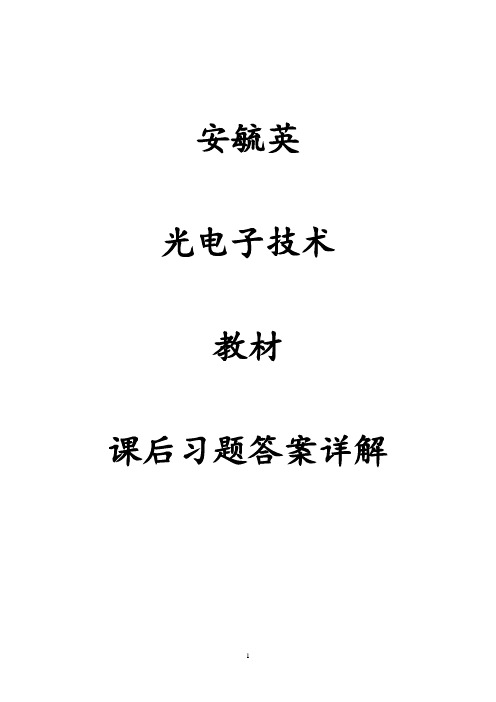
安毓英光电子技术教材课后习题答案详解习 题11. 设在半径为R c 的圆盘中心法线上,距盘圆中心为l 0处有一个辐射强度为I e 的点源S ,如图所示。
试计算该点源发射到盘圆的辐射功率。
2. 如图所示,设小面源的面积为∆A s ,辐射亮度为L e ,面源法线与l 0的夹角为θs ;被照面的面积为∆A c ,到面源∆A s 的距离为l 0。
若θc 为辐射在被照面∆A c 的入射角,试计算小面源在∆A c4. 霓虹灯发的光是热辐射吗?不是热辐射。
6. 从黑体辐射曲线图可以看出,不同温度下的黑体辐射曲线的极大值处的波长λm 随温度T 的升高而减小。
试由普朗克热辐射公式导出常数=T m λ。
这一关系式称为维恩位移定律,其中常数为2.898⨯10-3m ∙K 。
普朗克热辐射公式求一阶导数,令其等于0,即可求的。
9. 常用的彩色胶卷一般分为日光型和灯光型。
你知道这是按什么区分的吗?按色温区分。
习 题21. 何为大气窗口,试分析光谱位于大气窗口内的光辐射的大气衰减因素。
对某些特定的波长,大气呈现出极为强烈的吸收。
光波几乎无法通过。
根据大气的这种选择吸收特性,一般把近红外区分成八个区段,将透过率较高的波段称为大气窗口。
第1题图2. 何为大气湍流效应,大气湍流对光束的传播产生哪些影响?是一种无规则的漩涡流动,流体质点的运动轨迹十分复杂,既有横向运动,又有纵向运动,空间每一点的运动速度围绕某一平均值随机起伏。
这种湍流状态将使激光辐射在传播过程中随机地改变其光波参量,使光束质量受到严重影响,出现所谓光束截面内的强度闪烁、光束的弯曲和漂移(亦称方向抖动)、光束弥散畸变以及空间相干性退化等现象,统称为大气湍流效应。
5. 何为电光晶体的半波电压?半波电压由晶体的那些参数决定?当光波的两个垂直分量E x',E y'的光程差为半个波长(相应的相位差为π)时所需要加的电压,称为半波电压。
7. 若取v s=616m/s,n=2.35,f s=10MHz,λ0=0.6328μm,试估算发生拉曼-纳斯衍射所允许的最大晶体长度L max=?10. 一束线偏振光经过长L=25cm,直径D=1cm的实心玻璃,玻璃外绕N=250匝导线,通有电流I=5A。
光学第2章习题及答案

第二章习题答案2—1 铯的逸出功为1.9eV ,试求: (1)铯的光电效应阈频率及阈值波长; (2)如果要得到能量为1.5eV 的光电子,必须使用多少波长的光照射? 解:光电效应方程212m mv h =ν-Φ (1) 由题意知 0m v = 即 0h ν-Φ=14151.9 4.59104.13610ev Hz h ev s -Φν===⨯⨯⋅ 1.24652.61.9c hc nm Kev nm evλ⋅====νΦ(2) ∵ 21 1.52m mv ev =∴ 1.5cev h h λ=ν-Φ=-Φ 1.24364.71.5 1.5 1.9hc nm Kevnm ev ev evλ⋅===+Φ+2-2 对于氢原子、一次电离的氢离子He +和两次电离的锂离子Li ++,分别计算它们的: (1)第一、第二玻尔轨道半径及电子在这些轨道上的速度;(2)电子在基态的结合能; (3)由基态带第一激发态所需的激发能量及由第一激发态退激到基态所放光子的波长。
解:(1)由波尔理论及电子的轨道半径公式r 1为氢原子第一波尔半径22201122204()(197.3)0.0530.511e e c r a nm nm m e m c e 6πε====≈/4πε⨯10⨯1.44氢原子第二波尔半径可知:He + (Z=2)Li + + (Z=3)电子在波尔轨道上的速率为 于是有 H :61161212.19101371.1102v c m s m s cv m s 8--=α=⨯3⨯10/=⨯⋅α==⨯⋅21n n r r z=221140.212r n r r nm===112210.0265220.1062ar nmr a nm====112210.0176320.07053ar nmr a nm====nzv c n=αHe + :6116122 4.3810102v c m s c v m s--=α=⨯⋅2α==2.19⨯⋅ Li + + :6116123 6.5710102v c m s c v m s--=α=⨯⋅3α==3.28⨯⋅ (2) 电子在基态的结合能E k 在数值上等于原子的基态能量 由波尔理论的能量公式 可得故有 H : 13.6k E ev =He + : 213.6254.4k E ev =⨯= Li ++ : 213.63122.4k E ev =⨯=(3)以电压加速电子,使之于原子碰撞,把原子从基态激发到较高能态,用来加速电子的电势差称为激发电势,从基态激发到第一激发态得相应的电势差称为第一激发电势。
- 1、下载文档前请自行甄别文档内容的完整性,平台不提供额外的编辑、内容补充、找答案等附加服务。
- 2、"仅部分预览"的文档,不可在线预览部分如存在完整性等问题,可反馈申请退款(可完整预览的文档不适用该条件!)。
- 3、如文档侵犯您的权益,请联系客服反馈,我们会尽快为您处理(人工客服工作时间:9:00-18:30)。
(3-1-5) lc = c ∆ν
故:光源频率宽度越窄,相干时间越长,相干长度 也越长。
Ac ≈
λ 2 R2
∆As
(3-1-12)
相干面积:面积为AS的光源辐射出波长为λ的光波, 通过与光源相距为R且垂直于光的传播方向上的平 面两点,如果这两点位于Ac内,这两点的光场相 关,可产生干涉效应。
λ 2 R2 c i Vc = Ac lc = ∆As ∆ν
(3-1-13)
相干体积:在单位面积光源辐射出的单位频率宽度的 光波,在其传播方向上可产生干涉效应的范围。
3.谐振腔里两个反射镜的曲率半径份别为40cm,80cm, 求实现稳定腔工作时,腔长的取值范围。 解: R1=40cm>0,R2=80cm>0
2.一光束入射到长为10CM,增益系数为0.5CM-1的工作 物质中,求出射光强对入射光强的比值。 解: 利用增益系数的公式
1 I ( x) G = ln x I0
( 2 − 2 − 3)
Gx
⇒ I ( x) = I 0 e
I ( x = 10) Gx 0.5×10 5 =e =e = e ≈ 148 I0
⎛ L ⎞⎛ L⎞ ∵ 0 < g1 g 2 = ⎜1 − ⎟⎜ 1 − ⎟ < 1 ⎝ R1 ⎠⎝ R2 ⎠
( R1 − L)( R2 − L) <1 R1 R2 ∵ R1 R2 > 0 ∴ ( R1 − L)( R2 − L) < R1 R2
⇒ L2 -(R1 +R2) 0 L < L ⋅ [ L-(R1 +R2 )] < 0 ∵L > 0 ∴ L < R1 +R2
− LG
=e
= 0.905
L<R2<4L. 若R2<L或R2>4L都不能构成稳定腔。 令 L L
g1 = 1 −
R1
, g2 = 1 −
R2
则
g1 = 4 , 0 < g 2 < 3 3 4
故构成稳定腔的区域是g1=4/3的线段DK, 但端点D,K除外。
5.He-Ne激光器发出激光的中心频率为ν0=4.74×1014 Hz, 增益曲线上超过阀值的宽度∆ν=1.5×109Hz,令腔长L=1m, 问可能有多少个纵模输出?为获得单模输出,问腔长最长为 多少?
N 3 ( t) = N
30
e 1
− ( A 3 1 + A 3 2 )t
3
A32 E2 A31
A31 + A32 = ⇒ τ
3
τ
3
=
A31
1 + A32
三能级系统
E1
5.增益饱和现象产生的原因是什么? 是什么?
2 (υ -υ0) + (
饱和光强的物理意义
∆N = ∆N 0 (2-3-1) π c∆υ H ∆υ H 2 2 ) ( +I (υ -υ0) + ( ⋅1 ) 2 2η B21τ 2
(1 − 7 − 2 )
= 3 ×107 + 1.6 × 108 = 1.9 ×108 Hz 1 1 τH = = ≈ 8.4×10−9 s 2π ⋅∆ν H 2×3.14×1.9×108
(能级寿命缩短)
4.
已知粒子由能级E3自发跃迁到能级E1,E2的几率为 A31,A32,求粒子在能级E3上的自然寿命。
3.
已知某能级的自然宽度为30MHz,求粒子在该能级的自 然寿命。当压强增加使原子间的碰撞时间缩短到10-9s 时,粒子在该能级上的寿命是多少? 解:(1)
1 τ= A21
γ = A21 γ ∆ν N = 2π
1
(1 − 6 − 5) (1 − 6 − 19 )
1 1 ⇒τ = = ≈ = 5.3×10−9 s γ 2π ⋅∆ν N 2×3.14×3.0×107
0
R1
R2
(R1+R2)
0<L<40cm 或 80cm<L<120cm
4.谐振腔的一个反射镜的曲率半径与腔长的关系为R1=-3L,讨论R2的取值 情况并判定能否构成稳定腔。
解: 根据 0 < ⎛1 − L ⎞⎛1 − L ⎞ < 1, 代入R = −3L, 得 ⎜ 1 ⎟ ⎟⎜ ⎜ R ⎟⎜ R ⎟ 1 ⎠⎝ 2 ⎠ ⎝
∆υ H 2 ) 2
答:反转粒子数差值Δn与入射光强度和频率有关。 当光强I很小时,G(v)可视为跟I无关,值随光强而增大。 当I较大时,相当于光与工作介质的作用范围增大,效率提 高,消耗的反转粒子多,使△n剧减,故G(v) 随之减少,即 出现了增益随光强增大而下降的增益饱和现象。
饱和光强的物理意义是什么?
光电子学 习题
第二章 介质中的光增益
第三章
激光振荡与工作特性
第二章 介质中的光增益
1. 在增益介质中,一束光从x=0处出发,光强为I0。 经过5cm后光强增加一倍。当光强达到8I0时,光所 传播的距离是多少? 解:增益系数表达式:
G= 1 I ( x) ln x I0
( 2 − 2 − 3)
当x=5时,I(5)=2I(0)=2I0. 当I(x)=8I0 时,求x
π c∆ν H = Is = 2π τ 2 B 21 2π τ
2
π c (γ 2 π ) A 2 1 c 3 8 π hν 3η (
3
)
π c ⋅ γ ⋅ 8 π hν 3η 3 2 η 3 c hν 3 = = 3 2 π τ 2 ⋅ 2 π ⋅ A 21c τ 2 λ 3ν 3
= 2η
3 3
P42(2-3-2) 饱和光强的物理意义: 在折射率为η的工作介质里,小信号增益的最大光强值与 激发态能级的总寿命成反比,与输出光子的波长成反比。 或者说,能级寿命越短,输出频率越高,小信号增益的光 强范围越大。
λ
⋅
hc
τ
2
6.实现光放大的必要条件是什么? 答:粒子数反转是得到光放大的必要条件。
实现粒子数反转分布的条件: 内因:介质中必须含有亚稳态能级的结构。 外因:有激励源。
第三章激光振荡与工作特性
1.要使氦-氖激光器的相干长度达到1Km,它的单 色性∆λ/λ0应为多少? 解:根据P48式(3-1-2):
(2)自然加宽引起的能级寿命: τ = N
1 2π ⋅∆ν N
1 ⇒∆ν N = 2π ⋅τ N 同理,碰撞引起的频率加宽: 1 1 ∆ν L = = = 1.6 × 108 s 2π ⋅τ L 2 × 3.14 × 1× 10−9
自然加宽与碰撞加宽都属于均匀加宽: ∆ν H = ∆ν N + ∆ν L
解:
C 纵模间隔∆ν ′ = , 取η = 1, L = 1m 2ηL
则纵模输出的个数为:
⎛ ⎞ 3 × 10 ∆ν n= +1 = ⎜ + 1 = 11 9 ⎟ ∆ν ′ ⎝ 2 × 1× 1× 1.5 × 10 ⎠
8
−1
为使获得单模输出:
纵模间隔 1 ∆υ ′ ≥ ∆υ 2
1 C ′ ∆ν min = ∆ν = ′ 2 2η Lmax ′ Lmax C 3 × 10 = = = 0.2(m) 9 η∆ν 1.5 ×10
解:利用能级平均寿命公式:
τ
m
1 = = Am =
1
∑
m −1 i =1
Amj
τ
3
A31
1 + A32
4.
已知粒子由能级E3自发跃迁到能级E1,E2的几率为 A31,A32, 求粒子在能级E3上的自然寿命。
单位时间,E3能级的粒子数变化: 解: dN t) − dN 31+dN 32) ( ( ∴ 3 = = − A31+A32)N 3 t) ( ( dt dt 设t=0时,E3能级粒子数为N30,t时刻: E
λ2 ∆λ λ lc = ⇒ = ∆λ λ lc
He-Ne激光器的典型波长: ∵ λ = 632.8nm 632.8 ∴ = 12 = 6.328 × 10−10 λ 10 ∆λ
2. 说明相干长度、相干时间与光源的关系; 相干面积,相干体积的物理意义。
答:根据
lc = cτ c ,
τ c ∆ν = 1
1 I (5) 1 2 I 0 1 G5 = ln = ln = ln 2 5 I0 5 I0 5 1 I ( x) 1 8I 0 1 Gx = ln = ln = ln 8 x I0 x I0 x
工作介质仍为小信号增益,增益未饱和: Gx = G5 1 1 ln 8 = ln 2 5 x 5 ln 8 5 × 2 .0 8 x = ≈ = 1信号增益系数为1m-1的激光器的 激光振荡所要求的镜面反射率(设两镜面反射率相同,且 腔内损耗αi为 0)
解:
由r1r2 e
2 L ( G − ai )
≥ 1得 ,
− 0.1×1
r1r2 ≥ e
− 2 L ( G − ai )
∵ r1 = r2 , ai = 0, 则 rmin = e
⎛ L ⎞⎛ L⎞ ∵ 0 < g1 g 2 = ⎜1 − ⎟⎜ 1 − ⎟ < 1 ⎝ R1 ⎠⎝ R2 ⎠
( R1 − L)( R2 − L) >0 R1 R2 ∵ R1 R2 > 0 ∴ ( R1 − L)( R2 − L) > 0
⎧ ( R1 − L) > 0 ⎨ ⎩( R2 − L) > 0 ⇒ L < R1 , 且L < R2 (∵ R1(40 cm ) < R2(80 cm ) ) ∴ L < R1 ⎧ ( R1 − L) < 0 ⎨ ⎩( R2 − L) < 0 ⇒ L > R1 , 且L > R2 (∵ R2(80 cm ) > R1(40 cm ) ) ∴ L > R2
